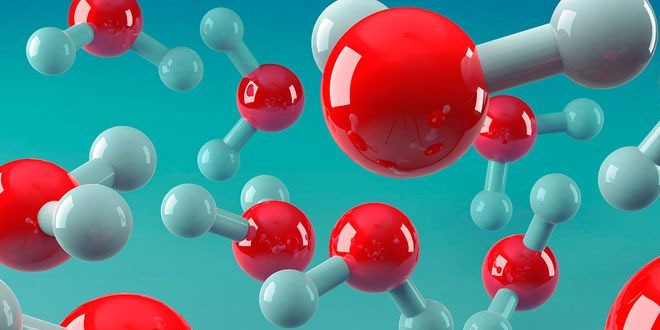Question: Arrange the following substances in increasing order of forces of attraction between the particles—water, sugar, oxygen.
Answer: Oxygen —> water —> sugar.
Question: Give two reasons to justify
- water at room temperature is a liquid.
- an iron almirah is a solid at room temperature.
Answer:
- Water at room temperature is a liquid because its freezing point is 0°C and boiling point is 100°C.
- An iron almirah is a solid at room temperature because melting point of iron is higher than room temperature.
Question: Why is ice at 273 K more effective in cooling than water at the same temperature?
Answer: Ice at 273 K will absorb heat energy or latent heat from the medium to overcome the fusion to become water. Hence the cooling effect of ice is more than the water at same temperature because water does not absorb this extra heat from the medium.
Question: What produces more severe bums, boiling water or steam?
Answer: Steam at 100°C will produce more severe bums as extra heat is hidden in it called latent heat whereas the boiling water does not have this hidden heat.
Question: Define matter.
Answer: Anything that occupies space and has mass is called matter.
Question: State different states of matter with an example.
Answer: Matter has 3 different states

Question: What is diffusion?
Answer: The intermingling of molecules of one substance with that of the other is called diffusion.
Question: What happen to the rate of diffusion if the temperature is increased?
Answer: With increased temperature, the rate of diffusion also increases as the particles gain energy and vibrate more.
Question: Name the state of matter that have the tendency to maintain their shape when subjected to outside force.
Answer: Solid.
Question: Define melting point.
Answer: The temperature at which a solid melts to become liquid at the atmospheric pressure is called its melting point.
Question: Define boiling point.
Answer: The temperature at which a liquid starts boiling at the atmospheric pressure is known as its boiling point.
Question: Define latent heat of vaporization.
Answer: Latent heat of vaporization is the heat energy required to change 1 kg of a liquid to gas at atmospheric pressure at its boiling point.
Question: Define latent heat of fusion.
Answer: Latent heat of fusion is the amount of heat energy required to change 1 kg of solid into liquid at its melting point.
Question: Define sublimation.
Answer: Sublimation is the change of gaseous state directly to solid state without going through liquid state and vice-versa.
Question: What is dry ice?
Answer: Solid carbon dioxide obtained by cooling and applying pressure on carbon dioxide gas. It does not melt so it is called dry ice.
Question: What is humidity?
Answer: The air holds water vapour, this air with water is called humid air and the phenomenon is called humidity.
Question: Give two properties of solid.
Answer:
- Solids have fixed shape and are rigid.
- Solids cannot be compressed.
Question: What will happen if the pressure is reduced on solid carbon dioxide (dry ice)?
Answer: If the pressure is reduced on solid carbon dioxide it will directly change into gaseous state without melting.
Question: dame any three substances that show sublimation.
Answer: Ammonium chloride, camphor and naphthalene balls.
Question: Sponge is solid, but we can still compress it. Why?
Answer: Sponge is a solid with minute pores in it. When we press the sponge the air present in these pores is released out and hence we are able to compress it.
Question: What is normal atmospheric pressure?
Answer: The atmospheric pressure at sea level is 1 atmosphere and taken as the normal atmospheric pressure.
Question: What is Kelvin?
Answer: Kelvin is the SI unit of temperature (0°C = 273 K).
Question: Give two examples of diffusion.
Answer: Milk drops dissolved in water and perfume sprayed in a room.
Question: Give the temperature at which water exists in two different phases/states.
Answer: At 0°C water can be in solid or in liquid state.
At 100°C water can be in liquid or in gaseous state.
Question: Why do we see water droplets collected on the outer surface of a glass container, containing ice?
Answer: The water vapour present in air, comes in contact with the cold outer surface of the container thereby condensing it to form water droplets.
Question: Explain why solids have fixed shape but liquids and gases do not have fixed shape.
Answer: Solids have fixed shape due to strong intermolecular force of attraction between them. The liquids and gases have molecules with less intermolecular force of attraction and hence they can flow and take shape of the container.
Question: Liquids and gases can be compressed but it is difficult to compress solids. Why?
Answer: Liquids and gases have intermolecular space, on applying pressure externally on them the molecules can come closer thereby minimizing the space between them. But in case of solids there is no intermolecular space to do so.
Question: A balloon when kept in sun, bursts after some time. Why?
Answer: The balloon has air filled in it. The balloon when kept in sun gets heated and the air inside it also gets heated. The molecules of air get energy, and vibrate faster thereby exerting large force on the walls of the balloon. Due to this expansion of gases the balloon bursts.
 Class Notes NCERT Solutions for CBSE Students
Class Notes NCERT Solutions for CBSE Students





